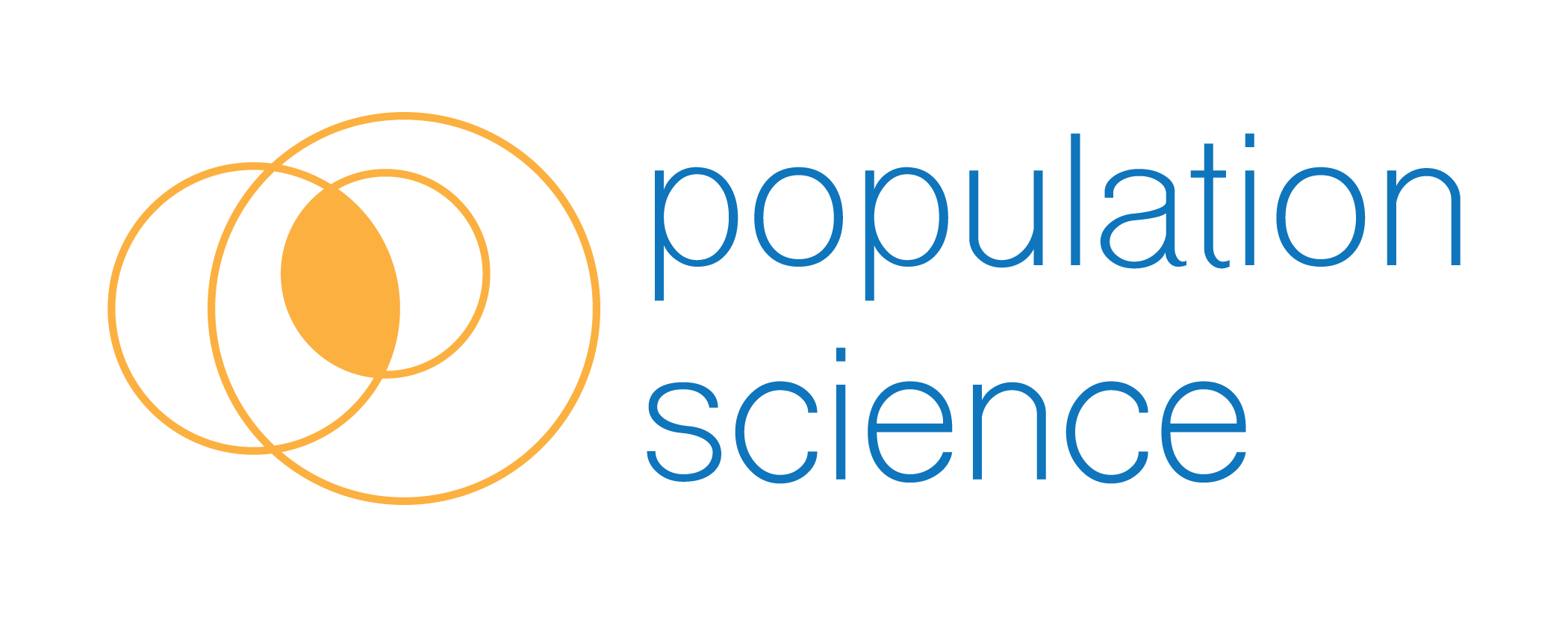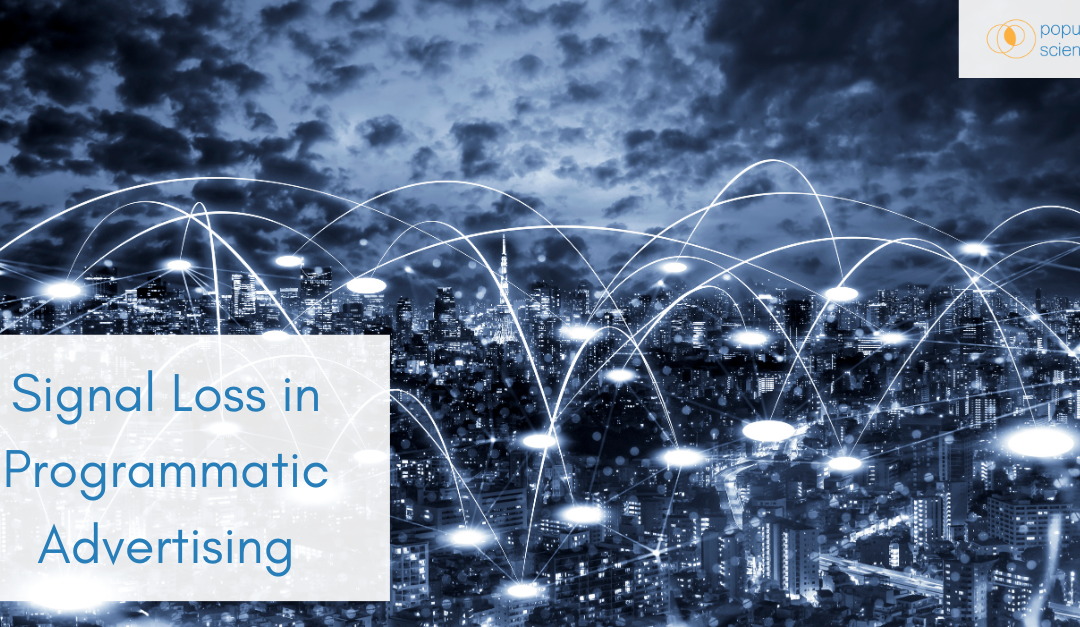
by Denae Luna | Oct 30, 2023 | Digital Marketing, Programmatic
Signal loss in programmatic advertising refers to the loss or degradation of data and information as it passes through various components of the programmatic advertising ecosystem. This loss can occur at multiple stages within the advertising process, from data collection to ad delivery.
Signal loss can have a significant impact on the efficiency and effectiveness of programmatic campaigns. Here are some key aspects of signal loss in programmatic:
Cookie Restrictions: Privacy regulations and browser restrictions have led to signal loss by limiting the availability and accuracy of cookies. This has made it challenging to track users and target them effectively.
Ad Fraud: Signal loss can be exacerbated by ad fraud, where fake or invalid data can be passed in the bidstream and impressions dilute the quality of data used in programmatic advertising. This makes it harder to distinguish genuine user behavior from fraudulent activity.
Data Transfer: Data transfer between different systems and platforms can result in signal loss if not handled properly. Data may be lost or altered during the transfer process. This can include user data, behavioral data, contextual data, IP address, and more.
Latency: Latency in the bidding and ad delivery process can cause signal loss. Delays in data transmission and decision-making can impact the relevance and timeliness of ad targeting. Bid auctions take place in milliseconds so it doesn’t take much of a glitch to create latency in the system.
Invalid Traffic and Impressions: Signal loss can occur when advertisers pay for impressions that are not seen by real users. Invalid traffic, such as non-human traffic (bots), can dilute the value of ad impressions.
Data Aggregation: Aggregating data from multiple sources for audience segmentation and targeting can lead to signal loss if the data is not consolidated accurately or if key details are missed.
Measurement Challenges: Signal loss can make it challenging to accurately measure campaign performance, making it difficult to understand the true impact of programmatic advertising efforts.
Retargeting Issues: Signal loss can hinder retargeting efforts, as tracking users across different devices or platforms may not be as accurate as desired.
Ad Personalization: Signal loss can impact the personalization of ad content. Advertisers may struggle to deliver highly relevant ads to users if data is lost or inaccurate.
Addressing signal loss in programmatic advertising requires implementing data quality controls, using advanced targeting techniques, and being aware of the limitations imposed by privacy regulations and browser changes. Advertisers and marketers often work with data providers, ad tech platforms, and data management solutions to mitigate signal loss and optimize programmatic campaigns. Additionally, continuous monitoring, analysis, and optimization are essential to minimize the impact of signal loss and ensure the success of programmatic advertising efforts. For a deeper dive into DSP buying, check out our Buyer’s Guide: https://populationscience.com/demand-side-platform-buyer-guide/

by Population Science | Oct 30, 2023 | Programmatic
Over the past five years I have had a lot of conversations with people about programmatic. I’m often surprised to learn that even many seasoned marketers have dismissed programmatic due to real or perceived obstacles. The reasoning for ignoring this incredibly effective opportunity generally fall into one of three buckets:
1. WE DON’T DO DISPLAY ADS.
There is a common misconception about programmatic just being a new way to buy display ads. The reality? Programmatic is so much more than display.
Programmatic does give you access to display ads on desktop and mobile devices. However, it also gives you access to native, video, and emerging formats such as connected TV, digital audio, and digital out of home. By accessing these diverse channels, programmatic gives you access to virtually every internet connected consumer in the United States to run data-driven digital campaigns to.
2. WE ARE OKAY WITH OUR CURRENT MARKETING MIX.
Marketers that buy directly from platforms such as Google AdWords or Facebook Business Manager and run retention programs via email are missing out on a big opportunity. Email, Facebook, and Google are fantastic platforms, but also limiting in their own ways. For example:
-
Meta is a great way to reach a large audience with robust targeting data. However, Facebook only reaches about 65% of the connected audience in the United States. People spend 70%+ of their connected time outside of social media. Programmatic is the most efficient way to reach people when they are not on social media as well as reaching those who aren’t on social media period.
-
Google AdWords provides access to its search engine, YouTube video, and Gmail native ads. You also get access to a wider display, native, and video network. While this seems robust, it pales in comparison to what programmatic offers. Emerging formats such as connected TV, digital out of home, and digital audio aren’t offered in AdWords. Further, programmatic provides full control over placements, access to a massive 3rd party data marketplace, and omni-channel controls that maximize efficiency across all of the available channels.
-
Email is a fantastic tool and it is something that should be a part of every marketing mix. That said, deliverability continues to get harder and open rates for most marketers continues to slide. In short, it’s getting harder to get a share of voice within consumer inboxes. Email alone isn’t enough to run successful retention or acquisition campaigns.
While email, Google, and Facebook are great ways for small businesses to do digital on a budget, it’s not nearly robust enough for serious digital marketers.
3. WE WOULD LOVE TO TRY PROGRAMMATIC, BUT WE DON’T HAVE THE RESOURCES (BOTH HUMAN AND FINANCIAL) TO RUN IT.
Yes, programmatic can be expensive. Most DSPs (Demand Side Platforms) require minimum spend commitments well into the six figures per year. If you require their assistance to setup and manage your campaigns (which most companies will because programmatic is very complex), 50% or more of your spend could be going to fees. That is a difficult pill to swallow.
If you are an agency or a brand that would love to get into programmatic, but do not have the internal resources or budget to do so, Population Science can help. We specialize in helping small to medium-sized organizations get into programmatic with personalized strategies, flexible minimums and a commitment to making programmatic accessible.
WHERE DO I START?
With all of the tactics and channels available in the programmatic space, you can run up a very large media bill pretty easily. For those of you looking to dip your toe in the water, here are a few places I suggest getting started:
-
Retargeting: Everyone retargets. Most people use Google Display Network, AdRoll, or Criteo for this. These are great platforms, but they are very limited in leveraging your retargeting data for prospecting campaigns (at least in a transparent way). Programmatic has all of the retargeting capabilities of these platforms plus much more.
-
Prospecting: Take the learnings from your website visitors, even with a smaller data set, and reapply that to an omni-channel prospecting campaign. We can model people that convert on your site with other browsers to find people who are currently in-market for your product or service. We can even leverage 3rd party data sources to further hone in on your target audience.
-
Connected TV: Connected TV is a channel that every marketer should be in on. It combines the impact of TV advertising with the targeting and tracking capabilities of digital ads. More than 80% of internet users currently stream at least some of their video content and this number is rapidly growing.
Ready to explore programmatic for your 2024 marketing? We’re here to help.
Whether you’re an agency with clients who could benefit from programmatic strategy or a business looking to reach new prospects and reengage customers in exciting ways, we’d love to chat about your needs and put together a plan for success.
Contact us today and let’s talk!
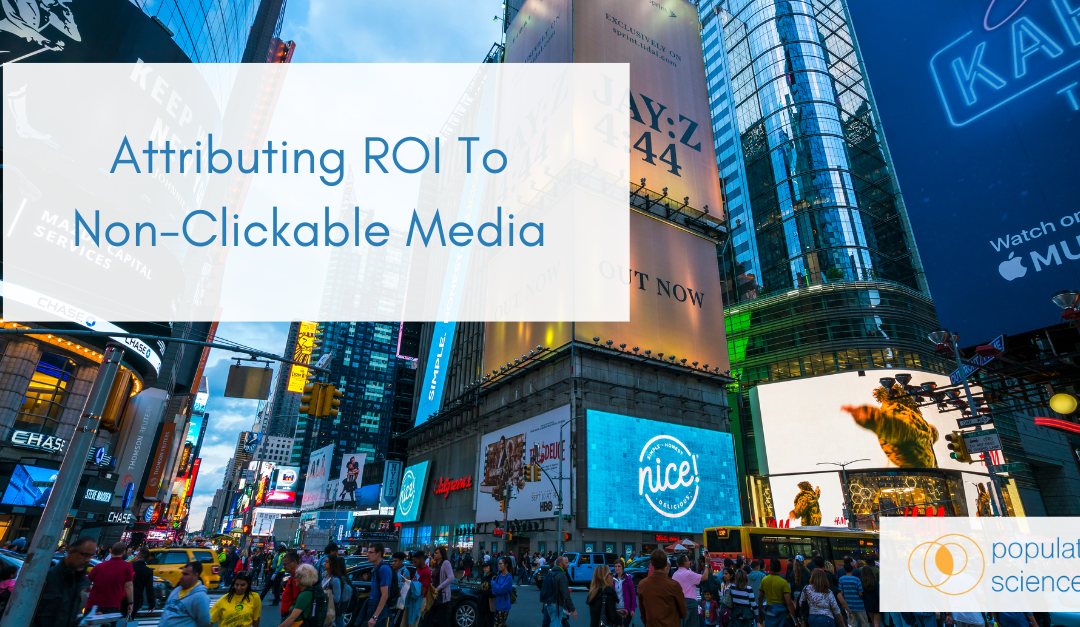
by Denae Luna | Oct 26, 2023 | Digital Marketing, Programmatic
Attributing Return on Investment (ROI) to Connected TV (CTV), Digital Out of Home (DOOH), and Streaming Audio ads can be challenging but essential for assessing the effectiveness of your advertising campaigns in these channels. To attribute ROI to these ad formats, consider the following strategies (ranked in order of most straightforward to most advanced):
Unique Tracking URLs, QR Codes, or Landing Pages:
Create unique tracking URLs or landing pages for each ad campaign in these channels. This enables you to track website visits, conversions, and other user interactions specific to these campaigns. For visual campaigns like DOOH or CTV you can embed a QR code so people can walk up to the screen, scan, and land on the desired page and track conversions.
Conversion Tracking:
Implement conversion tracking pixels or tags to monitor actions that are relevant to your ROI goals, such as website purchases, form submissions, or app downloads. Ensure that these tags are correctly implemented across all channels.
Custom Promo Codes:
Assign custom promo codes or coupons for each channel or campaign. When customers use these codes during a purchase, it becomes a direct attribution to the specific ad campaign.
Surveys and Feedback:
Collect feedback and conduct surveys to gather information directly from customers. Ask them about their awareness of and response to CTV, DOOH, and streaming audio ads in your campaigns.
Incrementality/Lift Testing:
Conduct A/B testing or incrementality testing by running control groups that are not exposed to your ads and comparing their behavior with those who were exposed. This can help isolate the impact of your campaigns.
Geo-Fencing and Geo-Targeting: 
Leverage geo-fencing and geo-targeting capabilities. For DOOH campaigns you can attribute ROI by measuring foot traffic or visits to physical locations near displays. For CTV and streaming audio you can measure lift by only running one channel in specific geos and compare them to geos not supported by that channel.
Attribution Modeling:
Use attribution models to analyze the customer journey and assign value to each touchpoint along the way. Multi-touch attribution models can help determine the influence of CTV, DOOH, and streaming audio ads in the conversion path.
Cross-Device Tracking:
Implement cross-device tracking to understand how users interact with ads on different devices before making a purchase. This is important because consumers may see an ad on CTV, then switch to a mobile device to complete a transaction.
Advanced Attribution Solutions:
Consider using advanced attribution solutions like marketing mix modeling (MMM) or time-series analysis to determine the impact of CTV, DOOH, and streaming audio in conjunction with other advertising channels.
Keep in mind that accurately attributing ROI to these channels may require a combination of the above methods and tools. It’s essential to develop a robust measurement and attribution strategy to track the effectiveness of your advertising efforts in CTV, DOOH, and streaming audio to make informed decisions and optimize your campaigns.
Are you ready to implement your DSP? Check out this article with a great starting strategy: https://populationscience.com/how-to-implement-a-demand-side-platform-dsp/
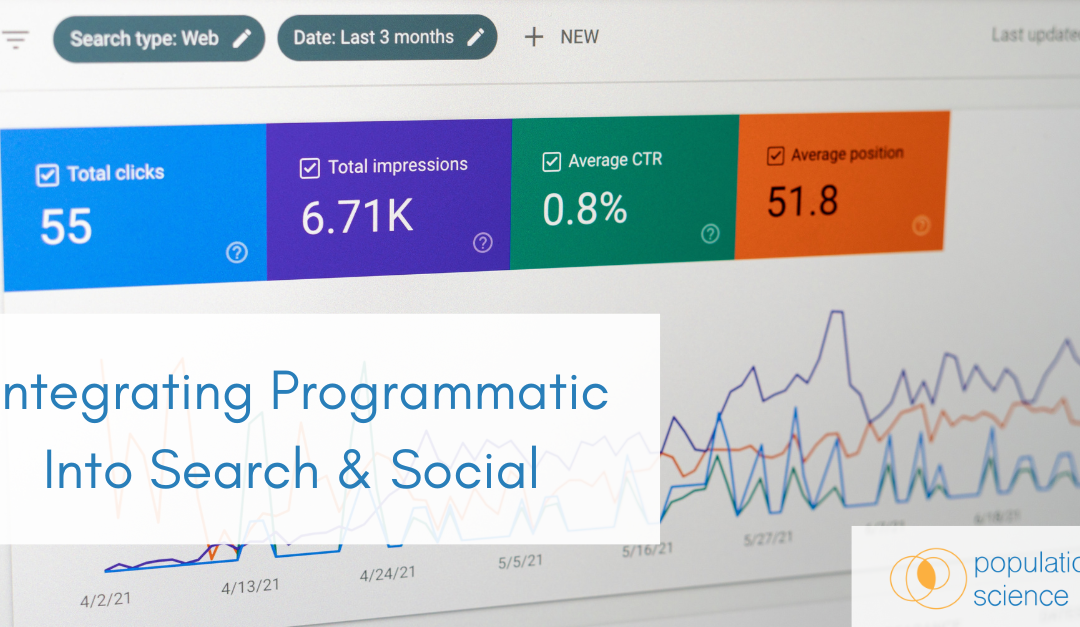
by Denae Luna | Oct 24, 2023 | Digital Marketing, Programmatic
Integrating programmatic advertising into your paid search and paid social strategy can help you create a more holistic and effective digital advertising approach. Here are steps to integrate programmatic into your paid search and paid social campaigns:
Set Clear Goals and Objectives:
Define specific goals for your integrated strategy, such as increasing brand awareness, driving website traffic, or boosting conversions and deploy it across paid search, paid social, and programmatic. This may sound like common sense, but you would be surprised how many media teams have their paid search, paid social, and programmatic strategy living in silos. You will have the maximum amount of success if all of your channels are in sync.
Data Sharing:
Encourage data sharing and collaboration between your programmatic, paid search, and paid social teams. Sharing insights and findings can lead to more effective cross-channel strategies.
Consistent Messaging:
Ensure that your messaging is consistent across programmatic, paid search, and paid social channels. A unified brand message helps reinforce your brand identity and message to your audience. Maintain a consistent visual style and branding elements in your ad creatives across all channels. This helps create a cohesive and memorable brand experience.
Cross-Channel Retargeting:
Use programmatic advertising to retarget users who have engaged with your paid search or paid social campaigns. Via programmatic campaigns you can greatly increase the number of places you can retarget search and social visitors including display, native, connected TV, and even digital audio. Increasing the number of channels you retarget on will ensure your message stays in front of interested audiences any time they are on a connected device. This will help nurture leads and guide them through the conversion funnel.
Leverage Data from Paid Channels:
Incorporate data from your paid search and paid social campaigns into your programmatic strategy. This can help you identify high-performing keywords for contextual tactics, ad creatives, and audience segments to use in programmatic campaigns.
Custom Audiences and Lookalike Audiences:
Use your website as an aggregator to track visitors from all of your paid media campaigns (search, social, and programmatic). This melting pot of data can be fed back into all channels to find lookalikes across all digital channels. Use
Unified Analytics & Attribution:
Use unified analytics and clearly define how attribution will be handled. This allows you to understand the contribution of each channel to your overall marketing efforts and allocate money across the most effective channels. You might be surprised how difficult this is for marketing teams. As more platforms introduce privacy-friendly defaults attribution is becoming more difficult. Paid search, paid social, and programmatic teams often end up fighting over taking credit for conversions which can cause discontent and more importantly lead to a lack of harmony between teams.
Cross-Channel Budget Allocation:
Determine how to allocate your budget across programmatic, paid search, and paid social based on campaign performance. Consider channel-specific ROI and adjust budgets accordingly.
Adapt to Trends and Changes:
Stay updated on industry trends and changes in advertising platforms to ensure your integrated strategy remains current and aligned with best practices. Programmatic is a constantly evolving area of media buying so it is vital to stay informed about new opportunities to target and reach your target audience.
Integrating programmatic into your paid search and paid social strategy requires careful planning, data sharing, and consistent messaging. When executed well, this approach can help you reach your audience across various touchpoints, improving brand visibility and the overall performance of your digital advertising efforts.
When you’re ready to implement programmatic into your efforts, check out our DSP implementation strategy here: https://populationscience.com/how-to-implement-a-demand-side-platform-dsp/

by Denae Luna | Oct 20, 2023 | Digital Marketing, Programmatic
Hiring a programmatic consultant can offer several advantages for businesses and advertisers looking to navigate the complex world of programmatic advertising. Here are some compelling reasons why you should consider hiring a programmatic consultant:
1. Expertise and Experience:
Programmatic consultants are experts in the field with extensive knowledge and experience in programmatic advertising. They stay up-to-date with industry trends, best practices, and the latest technologies, which can be challenging for in-house teams to maintain. Programmatic hasn’t been around as long as paid search or paid social so finding an expert with a lot of experience can be challenging. It can be even harder to hire a full time, experienced programmatic manager in-house.
2. Strategy Development:
Consultants can help you develop a customized programmatic advertising strategy tailored to your business objectives. They can assess your goals, target audience, and budget to create a plan that maximizes ROI. An experienced consultant can ensure your strategy is efficient, effective, and up to date with the latest tactics.
3. Cost Efficiency:
Consultants can optimize your programmatic campaigns to reduce wasted ad spend. They can help you make data-driven decisions, choose the right supply partners, and implement cost-saving measures.
4. Transparency and Accountability:
Programmatic consultants can improve transparency in your supply chain. Your supply chain is the Supply Side Partners (SSPs) and domains/apps you ultimately place your ads on. They can help you understand where your ad dollars are going and ensure that your campaigns are free from fraudulent activity.
5. Vendor and Technology Selection:
Consultants can guide you in selecting the right technology platforms and supply partners for your specific needs. They can help you negotiate contracts and make informed decisions about which vendors to work with. With so many vendors and traffic partners to choose from, simply knowing which ones you need to work with to achieve your unique goals can save you thousands of dollars per month.
6. Ad Creative and Messaging:
Consultants can provide recommendations for optimizing ad creatives and messaging to improve campaign performance and audience engagement. With so many channels and tactics the smallest nuance in creative can make a huge difference.
7. Data Analysis and Insights:
Consultants can analyze campaign data to extract valuable insights. They can identify trends, audience behaviors, and areas for improvement, helping you refine your advertising strategy and understand the ROI on your programmatic investment.
8. Compliance and Privacy:
With increasing privacy regulations like GDPR and CCPA, consultants can help ensure that your programmatic advertising practices comply with legal requirements, reducing the risk of fines and legal issues.
9. Adapting to Industry Changes:
The programmatic advertising landscape is constantly evolving. Consultants can help you adapt to changes in technology, regulations, and consumer behavior, ensuring that your campaigns remain effective and leverage the latest tactics.
10. Customized Solutions:
Consultants provide personalized solutions based on your unique business needs and challenges. They can adapt strategies to fit your industry, target audience, and competitive landscape.
11. Time Savings:
Outsourcing programmatic expertise to a consultant allows your internal team to focus on other critical tasks, such as core business functions and overall marketing strategy.
12. Objective Perspective:
Consultants offer an objective viewpoint, free from internal biases or politics. They can provide honest feedback and recommendations without being influenced by organizational dynamics.
13. Measurable Results:
Consultants can establish key performance indicators (KPIs) and regularly report on campaign performance, ensuring that you can track and measure the success of your programmatic efforts.
Overall, hiring a programmatic consultant can be a wise investment for businesses looking to leverage programmatic advertising effectively while minimizing risks and optimizing their advertising budget. Consultants bring expertise, objectivity, and a strategic approach that can lead to improved campaign results and a stronger return on investment.
Let us be a part of your journey. Learn more about how we can take your campaigns to the next level.
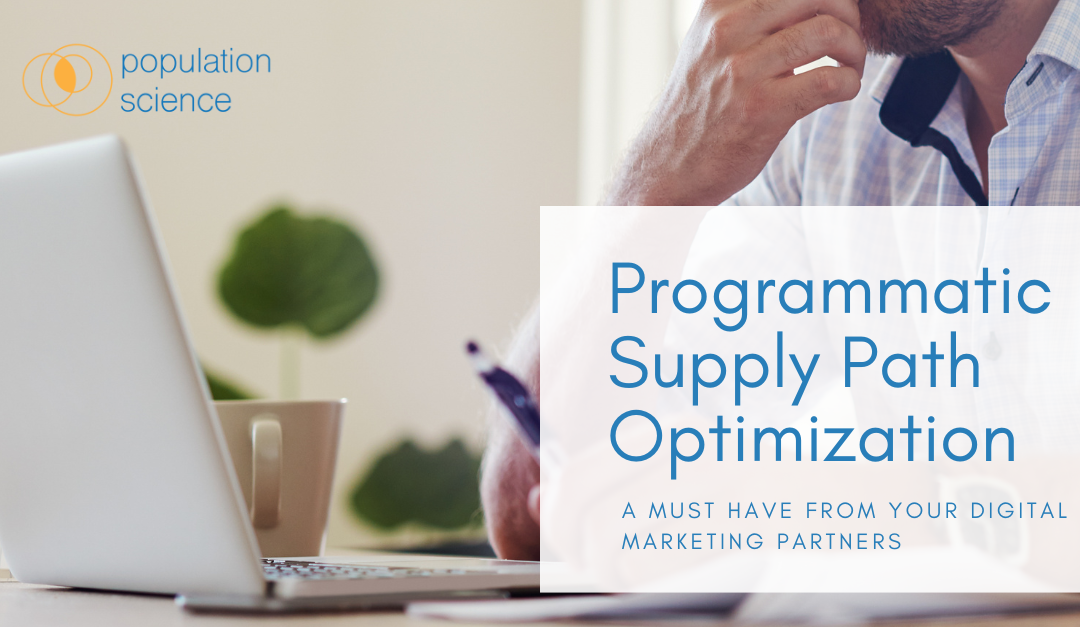
by Denae Luna | Oct 17, 2023 | Digital Marketing, Programmatic
Programmatic Supply Path Optimization (SPO) is a strategy used in digital advertising, particularly in programmatic advertising, to improve the efficiency and transparency of the supply chain. It involves optimizing the path through which digital ads are bought and sold, with the goal of maximizing the value for advertisers while minimizing costs and reducing potential fraud.
SPO is a response to the complexity and opacity often associated with programmatic advertising. In short, SPO is about finding the most direct path at the most affordable price to access quality impressions.
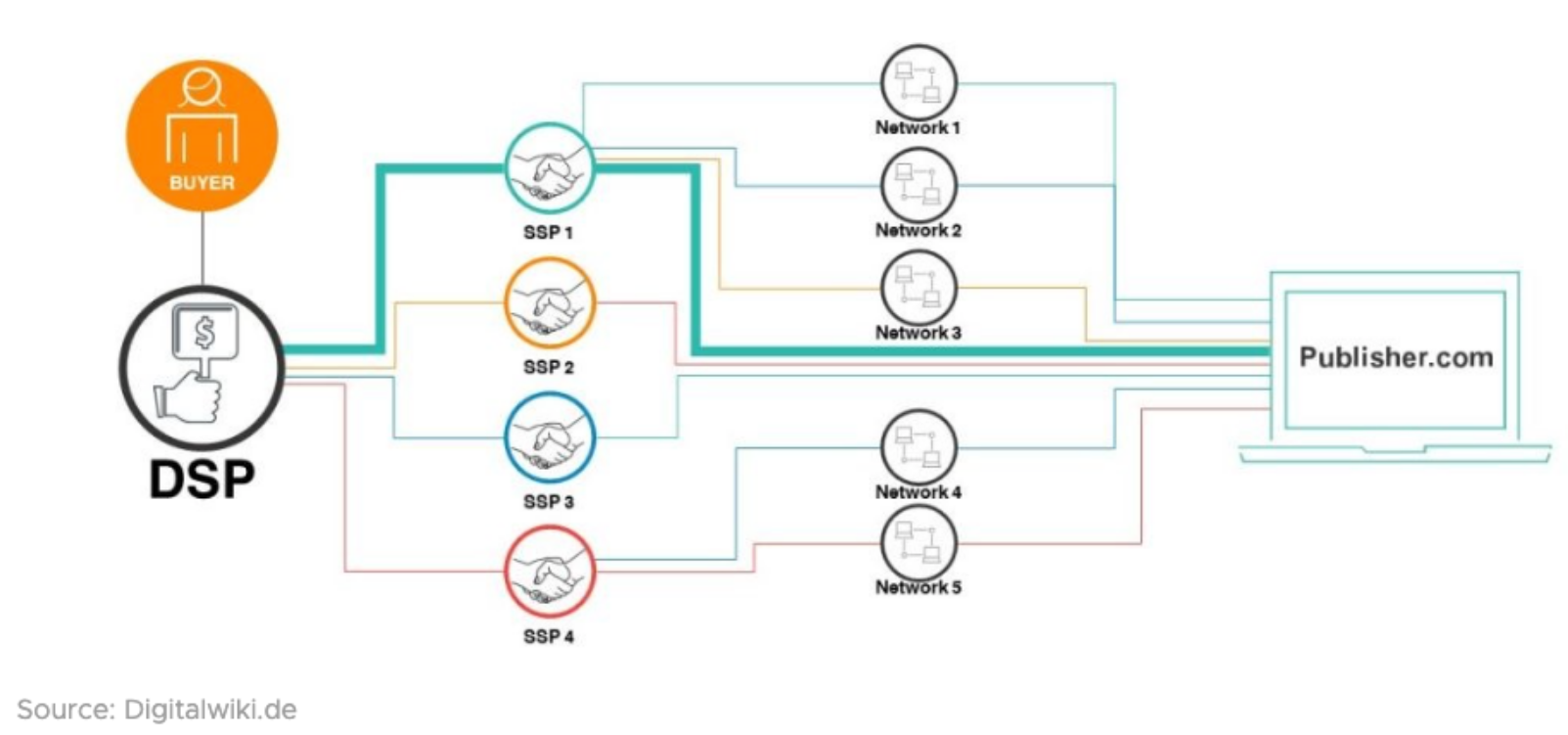
Here are the key components and objectives of Programmatic Supply Path Optimization:
Transparency: SPO aims to increase transparency in the programmatic supply chain. This involves identifying and understanding each step in the supply chain, including the intermediaries and technology platforms involved in the buying and selling of ads.
Cost Reduction: By streamlining the supply chain and reducing unnecessary intermediaries, SPO can help advertisers reduce the fees and costs associated with programmatic advertising. This can lead to improved return on investment (ROI).
Quality and Brand Safety: SPO can help advertisers ensure that their ads are displayed on high-quality, brand-safe websites and apps. It involves choosing the right supply partners and excluding low-quality or potentially harmful inventory sources.
Reducing Ad Fraud: SPO can also help in the detection and prevention of ad fraud. By working with trusted and reputable supply partners, advertisers can minimize the risk of fraudulent ad impressions or clicks.
Data Analysis: Advertisers may use real-time data and technology to make dynamic decisions about which supply paths to use for each impression, optimizing based on factors like price, performance, and quality.
Consolidation: SPO often involves consolidating the number of supply partners or intermediaries involved in a campaign. Fewer intermediaries can lead to a more efficient and cost-effective supply chain.
Relationship Building: Building strong relationships with supply partners is another aspect of SPO. Collaborative partnerships can lead to better communication, trust, and more effective campaign management.
In summary, programmatic supply path optimization is a strategy that advertisers use to make their programmatic advertising campaigns more efficient, transparent, and cost-effective. It involves careful selection of supply partners, data analysis, and ongoing optimization to achieve better results in the complex world of programmatic advertising.
Want some more help making a programmatic decision? Check out our Demand Side Platform Buyer’s Guide: https://populationscience.com/demand-side-platform-buyer-guide/

